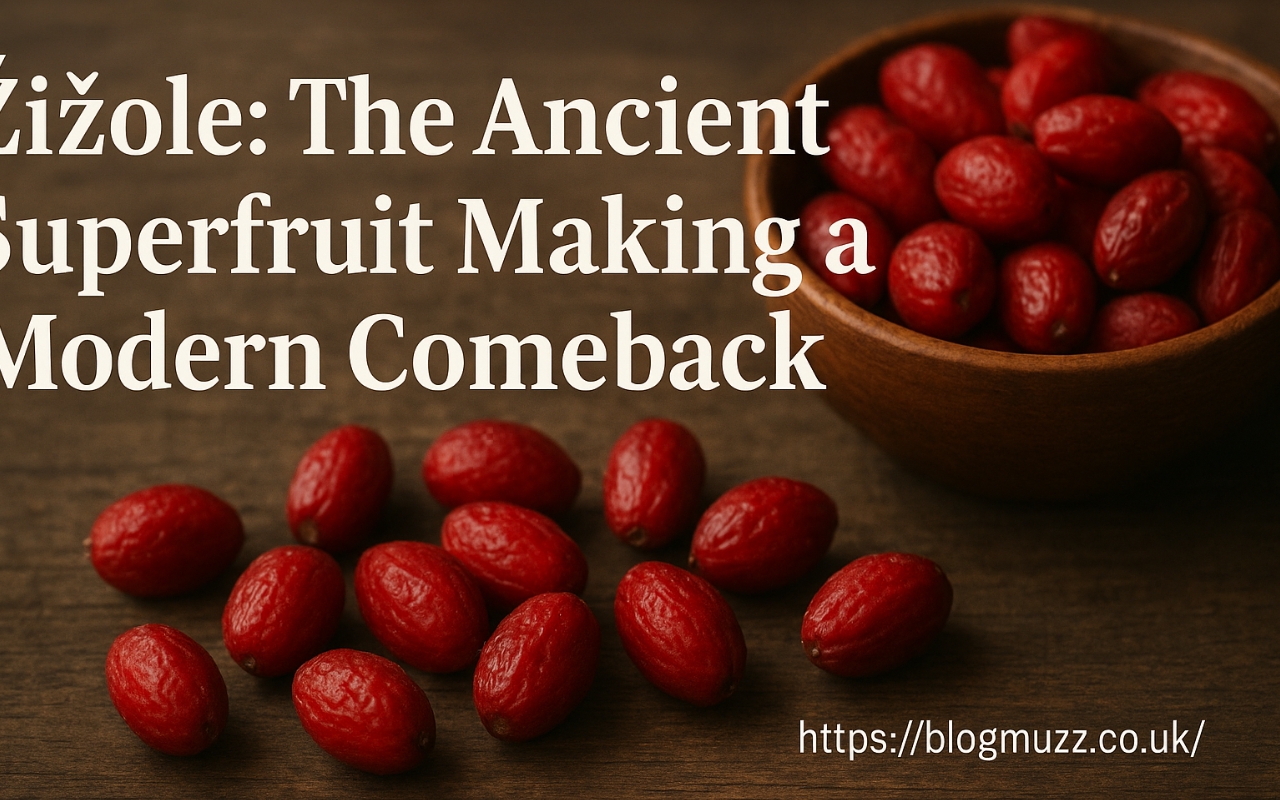Introduction: A Forgotten Treasure in the World of Fruits
In the vast family of fruits that humanity has cultivated and cherished over the centuries, there are some that rise and fall with the tides of time. One such gem is the žižola, known in English as the jujube or Chinese date. Once a beloved fruit across the Mediterranean and Asia, žižole are now quietly making a comeback — not only in traditional markets but also in the world of modern wellness, nutrition, and gourmet cuisine.
These small, round, or oval fruits, with their shiny reddish-brown skin and sweet, apple-like taste, have been grown and valued for more than 4,000 years. Ancient civilizations recognized their medicinal and nutritional power long before modern science began to uncover their secrets. Today, as the world rediscovers the benefits of natural, organic, and heritage foods, žižole are stepping back into the spotlight as one of the most underrated superfruits of our time.
The Origins and History of Žižole
The history of žižole is as rich as its taste. Belonging to the botanical family Rhamnaceae, the fruit originates from southern Asia, most likely from the region encompassing northern India and China. From there, it spread westward along the Silk Road, reaching Persia, the Middle East, and eventually the Mediterranean coast, where it found a particularly welcoming home.
In the Dalmatian region of Croatia, for instance, žižole trees have been cultivated for centuries. Local families often grow them in small orchards or backyards, valuing the fruit not just for its flavor but for its symbolic and medicinal qualities. The žižola tree, known for its resilience, can survive droughts and poor soil conditions — traits that made it a perfect companion for Mediterranean farmers.
Historical texts from ancient China and Greece describe the fruit as both a food and medicine. Chinese traditional medicine used it to calm the mind, improve sleep, and strengthen the immune system, while ancient Greek and Roman healers prescribed it for digestion and throat ailments. Over millennia, žižole earned a reputation as a fruit that “brings peace to the soul and health to the body.”
The Žižola Tree: Beauty, Resilience, and Abundance
The žižola tree (Ziziphus jujuba) is a small, deciduous tree that rarely exceeds 10 meters in height but can live for decades, even centuries. Its delicate, shiny leaves and thorny branches give it a graceful yet rugged appearance. The tree blooms in early summer, producing small yellow-green flowers that later turn into the distinctive fruits.
One of the most fascinating traits of the žižola tree is its ability to thrive in harsh conditions. It tolerates drought, heat, and poor soil better than most fruit trees. This resilience has made it a favorite among farmers in semi-arid regions. The tree is also resistant to many pests and diseases, which means it often requires little to no chemical treatment — a major advantage in today’s environmentally conscious agriculture.
In autumn, when the fruits ripen, žižole transform from green to yellow and finally to a deep reddish-brown color. As they mature, they become sweeter and drier, resembling small dates — which is why they’re often called “Chinese dates.” Some varieties are eaten fresh, while others are sun-dried, candied, or used in traditional syrups and liquors.
Nutritional Powerhouse: What Makes Žižole a Superfruit
The rise of žižole as a modern superfruit is no coincidence. Nutritional studies have revealed that these small fruits pack an impressive concentration of vitamins, minerals, antioxidants, and phytochemicals.
A single serving of fresh žižole (about 100 grams) provides:
- Vitamin C: up to 70–80 mg — nearly equivalent to an orange.
- B vitamins: including B1, B2, and B6, essential for energy and brain health.
- Minerals: such as potassium, magnesium, calcium, phosphorus, and iron.
- Antioxidants: including polyphenols and flavonoids that combat free radicals.
- Dietary fiber: promoting digestive health and satiety.
But what truly sets žižole apart is its balance of natural sugars and beneficial compounds. Unlike many sweet fruits, žižole have a low glycemic index, meaning they don’t cause sharp spikes in blood sugar levels. This makes them a great option for those managing diabetes or seeking steady energy throughout the day.
Furthermore, the presence of saponins, betulinic acid, and jujubosides has drawn scientific attention due to their potential roles in anti-inflammatory, anti-cancer, and neuroprotective effects. These compounds have been studied for their ability to reduce stress, improve sleep quality, and even support cardiovascular health.
Health Benefits of Žižole: Ancient Wisdom Meets Modern Science
Throughout history, žižole have been celebrated for their healing power. Modern research has only confirmed what traditional medicine knew centuries ago. Let’s explore some of the most notable health benefits associated with this remarkable fruit:
1. Promotes Restful Sleep and Reduces Anxiety
In traditional Chinese medicine, žižole are used to calm the spirit and treat insomnia. Science now supports this use: compounds like jujubosides have a mild sedative and anti-anxiety effect. They interact with neurotransmitters such as GABA, promoting relaxation and better sleep without the side effects of synthetic medications.
2. Supports Immune System Health
Thanks to its high vitamin C and antioxidant content, žižole boosts the immune system by protecting cells from oxidative stress. Regular consumption can help prevent colds, infections, and even speed up recovery after illness.
3. Improves Digestion and Gut Health
Žižole contain soluble and insoluble fiber that supports digestion and promotes healthy bowel movements. They also have mild prebiotic properties, meaning they feed the beneficial bacteria in your gut, improving microbiome balance.
4. Enhances Skin and Hair Health
Vitamin C, along with antioxidants and trace minerals, helps in collagen production, giving the skin a youthful glow. Some natural beauty products in Asia even use žižole extracts to improve skin elasticity and fight acne.
5. Balances Blood Sugar and Supports Heart Health
With a low glycemic index and rich potassium content, žižole can help stabilize blood sugar levels and regulate blood pressure. The fruit’s natural compounds may also reduce bad cholesterol (LDL) and improve overall cardiovascular function.
6. Anti-inflammatory and Detoxifying Properties
Žižole’s antioxidants help the body combat chronic inflammation — a root cause of many modern diseases. Their mild detoxifying effect also supports liver function, helping flush out toxins naturally.
Traditional Uses of Žižole Around the World
The versatility of žižole is one reason it has endured for millennia. Different cultures have found unique ways to use the fruit — in food, medicine, and even ritual practices.
- China: In Chinese medicine, žižole (known as hong zao or da zao) are boiled in teas or soups to nourish the blood and calm the mind. They’re also used in tonics for fatigue and menstrual health.
- Middle East: Dried žižole are sometimes mixed with nuts and honey as an energy-boosting snack.
- Mediterranean (especially Croatia and Italy): The fruit is used to make žižola liqueur (rakija od žižola), jams, and syrups. In Dalmatia, žižole are a symbol of autumn, often enjoyed during harvest festivals.
- India: The fruit, called ber or badari, is eaten fresh or dried and used in Ayurvedic medicine to balance energy and treat throat or digestive issues.
This diversity of use shows that žižole are more than just food — they are part of cultural identity and a link between tradition and wellness.
How to Eat and Enjoy Žižole
If you’ve never tried žižole before, you’re in for a pleasant surprise. Depending on the stage of ripeness, the taste and texture vary significantly:
- Fresh žižole (green to yellow-brown): Crisp and mildly sweet, similar to apples. Perfect for snacking or adding to salads.
- Fully ripe žižole (reddish-brown): Soft and date-like, with a richer sweetness. Ideal for desserts or eating on their own.
- Dried žižole: Chewy, caramel-like, and perfect for teas, baking, or mixing into trail mixes.
Creative Ways to Use Žižole
- Žižole Tea: Simmer dried žižole with ginger and honey for a soothing drink.
- Žižole Jam: Combine ripe žižole with sugar and lemon juice for a sweet, tangy spread.
- Žižole Liquor: Traditional in Dalmatia — žižole steeped in brandy for a few months creates a smooth, fragrant drink.
- Baked Goods: Add chopped žižole to muffins, bread, or cookies for a natural sweetness boost.
- Healthy Snacks: Mix dried žižole with almonds, figs, and walnuts for an energy-rich mix.
Growing Žižole: Bringing Ancient Trees to Modern Gardens
One reason žižole are making a comeback is their ease of cultivation. Whether you’re a commercial farmer or a home gardener, these trees require minimal maintenance and can adapt to various climates.
Tips for Growing Žižole:
- Climate: Thrive in warm, sunny locations; tolerate both drought and cold.
- Soil: Prefer well-drained soil but are not picky about fertility.
- Watering: Young trees need regular watering, but mature ones are drought-resistant.
- Pruning: Annual pruning helps maintain shape and encourages fruiting.
- Harvesting: Fruits are ready in late summer or early autumn, depending on the region.
Because žižole trees are hardy and pest-resistant, they are an excellent sustainable crop for farmers looking to diversify production in dry or marginal lands. Some regions in Croatia, southern Italy, and Spain are already reviving žižole cultivation as part of agro-tourism and organic farming projects.
Žižole in Modern Wellness and Culinary Trends
As global consumers shift toward natural and nutrient-rich foods, žižole are emerging as a superfruit with a story — combining ancient tradition with contemporary health trends.
In the Wellness Industry
- Jujube powder and extracts are appearing in herbal supplements and natural sleep aids.
- Žižole teas and tonics are marketed for stress relief and immune support.
- Skincare brands use žižole seed oil for its anti-aging and moisturizing properties.
In Modern Cuisine
Chefs and food enthusiasts are rediscovering žižole as a versatile ingredient. From gourmet desserts to fusion dishes, its subtle sweetness pairs beautifully with cheese, nuts, honey, and chocolate. High-end restaurants in Europe and Asia have even started using žižole-based sauces and glazes for meat and seafood dishes.
This renewed interest also benefits local farmers and artisans, especially in the Mediterranean, where traditional žižole cultivation supports sustainable rural economies and eco-tourism.
The Future of Žižole: A Fruit for the Next Generation
The growing global attention toward žižole is more than just a food trend — it’s a cultural revival. As people seek healthier, more authentic, and sustainable foods, ancient fruits like žižole are finding new relevance.
Farmers are planting new orchards, researchers are studying the fruit’s bioactive compounds, and wellness companies are exploring its potential for supplements and skincare. What was once a forgotten fruit in rural backyards is now a symbol of resilience, tradition, and health.
By reconnecting with fruits like žižole, we not only enrich our diets but also honor agricultural heritage and the wisdom of generations past. It’s a small but meaningful way of blending old and new — tradition and innovation — in pursuit of better living.
Conclusion: A Sweet Return to Nature
Žižole are more than just a delicious fruit; they’re a bridge between ancient knowledge and modern health. With their remarkable nutritional profile, diverse culinary uses, and deep cultural roots, žižole truly deserve the title of an “ancient superfruit making a modern comeback.”
Whether you’re sipping on žižole tea, planting a tree in your garden, or simply enjoying a handful of the dried fruit, you’re partaking in a tradition that spans continents and centuries. As the world rediscovers this humble yet powerful fruit, žižole remind us of a simple truth: sometimes the best things for our bodies — and our souls — have been with us all along.


